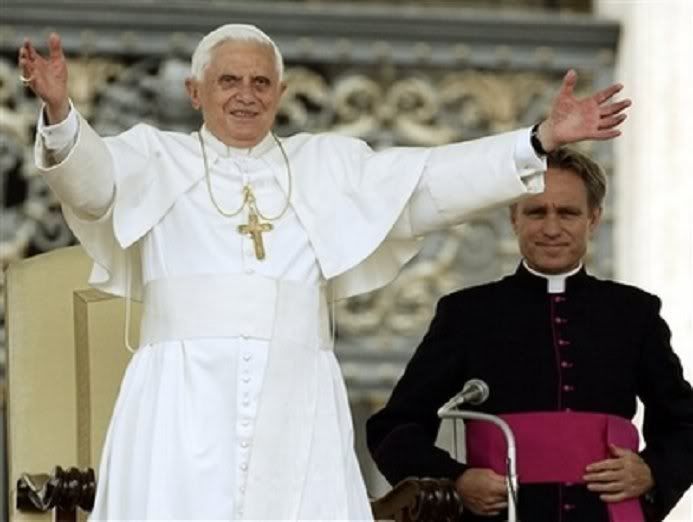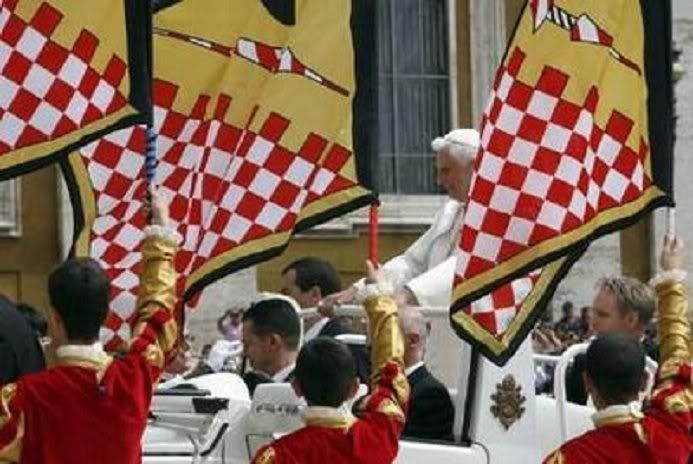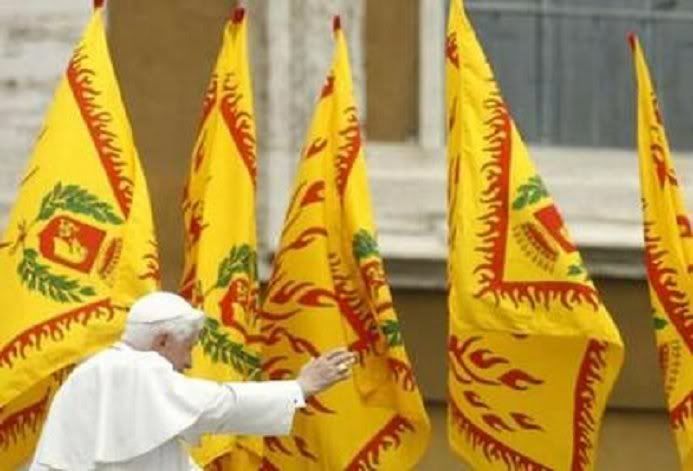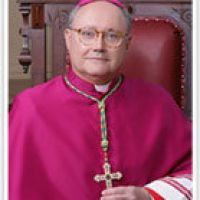 It is Wednesday that means it is Pope Benedict Wednesday audience time!!! As usual he is hitting the Church Fathers. Today it is the sainted abbot Columban, the most famous Irishman of the Middle Ages. Thanks to the Ratzinger Forum for the translation as well as the pics. WE HAVE LOTS OF FLAGS). If you wish to have a much neater translation from the News wire keep your eye on this entry that I am sure Blog by the Sea with update with those full translations.
It is Wednesday that means it is Pope Benedict Wednesday audience time!!! As usual he is hitting the Church Fathers. Today it is the sainted abbot Columban, the most famous Irishman of the Middle Ages. Thanks to the Ratzinger Forum for the translation as well as the pics. WE HAVE LOTS OF FLAGS). If you wish to have a much neater translation from the News wire keep your eye on this entry that I am sure Blog by the Sea with update with those full translations. Dear brothers and sisters, Today, I wish to speak about the sainted abbot Columban, the most famous Irishman of the Middle Ages. With good reason, he may be called a 'European' saint, because as monk, missionary and writer, he worked in different countries of western Europe. Together with the Irish of this time, he was aware of the cultural unity of Europe. In a letter of his written around 600 to Pope Gregory the Great, one finds for the first time the expression 'totius Europae - of all Europe - referring to the presence of the Church on the continent (cfr Epistula I,1).
Dear brothers and sisters, Today, I wish to speak about the sainted abbot Columban, the most famous Irishman of the Middle Ages. With good reason, he may be called a 'European' saint, because as monk, missionary and writer, he worked in different countries of western Europe. Together with the Irish of this time, he was aware of the cultural unity of Europe. In a letter of his written around 600 to Pope Gregory the Great, one finds for the first time the expression 'totius Europae - of all Europe - referring to the presence of the Church on the continent (cfr Epistula I,1).
Columban was born around 545 in the province of Leinster, southeast Ireland. Educated in his own home by the best teachers, who started him on liberal arts studies, he was later entrusted to the guidance of Abbot Sinell of the Cluain-Inis community in northern Ireland, where he was able to deepen his studies of Sacred Scriptures.
At almost twenty years of age, he entered Bangor monastery in the northeastern part of the island, under Abbot Comgall, a monk famous for his virtue and rigorous asceticism. In full harmony with his abbot, Columban zealously practised the severe discipline of the monastery, leading a life of prayer, asceticism, and study. He was ordained a priest there. The life in Bangor and the example of the abbot influenced the concept of monasticism that Columban matured with time and spread in the course of his life.
 When he was almost 50, following the typically Irish ascetic ideal of 'peregrinatio pro Christo' - to be a pilgrim for Christ - Columban left Ireland with 12 companions to undertake missionary work on the European continent. We should remeember that at that time, migrations of peoples from the north and the east had caused entire Christianized regions to fall back into paganism. Around 590, this small missionary team landed on the Breton coast [western France]. Welcomed benevolently by the King of the Franks of Austrasia [present-day France], they asked him simply for a piece of untilled land.
When he was almost 50, following the typically Irish ascetic ideal of 'peregrinatio pro Christo' - to be a pilgrim for Christ - Columban left Ireland with 12 companions to undertake missionary work on the European continent. We should remeember that at that time, migrations of peoples from the north and the east had caused entire Christianized regions to fall back into paganism. Around 590, this small missionary team landed on the Breton coast [western France]. Welcomed benevolently by the King of the Franks of Austrasia [present-day France], they asked him simply for a piece of untilled land.
They were given the ancient Roman fort of Annegray, which was in ruins and abandoned, and by now, overgrown by forest. Used to a life of extreme renunciation, the monks succeeded within a few months to build their first hermitage on the ruins. Thus, their work of re-evangelization started through the testimony of their own life. With their cultivation of the soil, they also started the cultivation of souls. The fame of these foreign religious people who, living on prayer and in great austerity, built homes and tilled the land, quickly spread, attracting pilgrims and penitents.
Above all, many young people asked to be welcomed into their monastic community to live, as they did, this exemplary life which revived cultivation of the earth as well as of souls. Soon, it became necessary to establish a seocnd monastery. It was built a few kilometers away on the ruins of an old thermal resort, Luxeuil. It would become the center for radiating out the monastic and missionary tradition of Ireland towards the European continent. A third monastery was erected in Fobntaine, an hour's walk to the north. Columban lived in Luxeuil for almost 20 years. here, the saint wrote for his followers the Regola monachorum - monastic rules - which were for some time more widespread in Europe than the Rule of St. Benedict, in which he outlined the ideal image of the monk. It is the only ancient Irish monastic rule that we now have.
 Integral to it, he also elaborated the Regula coenobialis, a kind of penal code that is surprising for its modern senisbility, and which can only be explained by the mentality and cultural climate of the time. With another famous work entitled De poenitentiarum misura taxanda, also written at Luxeuil, Columban introduced confession, with private and repeated penitence, to the continent. It was called a 'penitence by tariff' because of the proportion established between the gravity of the sin and the type of penitence imposed by the confessor. This novelty aroused the suspicions of the bishops of the region, a mistrust that changed to hostility when Columban had the courage to reproach them openly for some of their practices.
Integral to it, he also elaborated the Regula coenobialis, a kind of penal code that is surprising for its modern senisbility, and which can only be explained by the mentality and cultural climate of the time. With another famous work entitled De poenitentiarum misura taxanda, also written at Luxeuil, Columban introduced confession, with private and repeated penitence, to the continent. It was called a 'penitence by tariff' because of the proportion established between the gravity of the sin and the type of penitence imposed by the confessor. This novelty aroused the suspicions of the bishops of the region, a mistrust that changed to hostility when Columban had the courage to reproach them openly for some of their practices.
An occasion for the manifestation of such a confrontation was the dispute over the date of Easter: Ireland had been following the Oriental tradition rather than the Roman. Columban was summoned in 693 to Châlon-sur-Saôn to answer to a synod about his practices regarding penitence and Easter. Instead of presenting himself to the Synod, he sent a letter in which he minimized the issue and invited the Synod fathers to discuss not only the date for Easter, a minor problem in his view, "but also - something more serious - all the necessary canonical norms which many have not complied with" (cfr Epistula II,1). At the same time, he wrote Pope Boniface IV - as he had written several years earlier to Pope Gregory the Great (cfr Epistula i) - to defend the Irish tradition (cfr Epistula III). Intransigent as he was on every moral question, Columban also came into conflict with the royal house because he had sharply reproached King Theodoric for his adulterous relations.
This led to a network of intrigues and maneuvers on a personal, religious and political level which, in the year 610, resulted in a decree of expulsion from Luxeuil of Columban and all monks of Irish origin, condemning them to exile. They were escorted out to sea to be shipped back to Ireland at the expense of the court. But the ship ran aground not far from the beach; and the captain, seeing in this a sign from heaven, gave up the undertaking, and for fear of being cursed by God, he brought back the monks to safe ground. But instead of returning to Luxeuil, they decided to start a new phase of evangelization

They headed to the Rhine and sailed upstream. After a first stop at Tuggen near Lake Zurich, they proceeded to the Bregenz region near Lake Constance to evangelize the Germanic tribes. Soon after, however, Columbna, because of political events which were not favorable to his work, decided to cross the Alps with most of his disciples. The only one left behind was a monk called Gallus. His hermitage eventually developed into the famous Abbey of Sankt Gallen in Switzerland.
Arriving in Italy, Columban found a benevolent welcome at the royal Lombard court, but he soon had to face remarkable difficulties: the life of the Church was being torn by the Arian heresy which was still prevalent among the Lombards, and by a shcism that had detached the greater part of the churches in northern Italy from communion with the Bishop of Rome. Columban entered the dispute authoritatively, writing a pamphlet against Arianism and a letter to Boniface IV to convince him to take decisive steps in order to re-establish unity (cfr Epistula V). When the king of the Lombards, in 612 o3 613, assigned him some land in Bobbio, in the valley of the Trebbia, Columban founded a new monastery whoch would later become a center of culture comparable to the famous one at Montecassino.
Here he reached the end of his days. He died on November 23, 615, the day on which he is commemorated in the Roman rite up to our time. The message of St. Columban is focused on a firm call for conversion and for detachment from earthly goods in the light of the eternal heritage. With his ascetic life and his uncompromising behavior in the face of corruption among the powerful, he evokes the severe figure of John the Baptist. But his asceticism was never an end in itself - only the means to open himself freely to the the love of God and to respond with all his being to the gifts he received, thus reconstructing in himself the image of God while tilling the soil and renewing human society.
I cite from his Instructiones: "If man correctly uses the faculties that God has granted his spirit, then he will be similar to God. Let us remember that we must give back to him all the gifts which he endowed us with when we were in our original condition. He has taught us the way with his commandments. The first of those is to love the Lord with all our heart, because it was he who loved us first, from the beginning of time, before we even came to this world" (cfr Instr. XI). The Irish saint truly embodied these words in his own life.
A man of great culture - he wrote poems in Latin and a book of grammar - he showed himself to be rich in gifts of grace. He was a tireless builder of monasteries as well as an intransigent preacher of penitence, spending all his energies to nourish the Christian roots of the Europe which was being born. With his spiritual energy, his faith, his love of God and neighbor, he was truly one of the Fathers of Europe. He shows us even today the roots from which our Europe can be reborn.
Here is how he synthesized the catechesis in English:
In today’s catechesis we turn to Saint Columban, one of the many Irish monks who contributed to the re-evangelization of Europe in the early Middle Ages. Columban made his monastic profession in Bangor, Ireland, and was ordained a priest. At the age of fifty, he left the monastery to begin missionary work in Europe, where entire regions had lapsed into paganism. Beginning in Brittany, Columban and his companions established monasteries at Annegray and Luxeuil. These became centres for the spread of the monastic and missionary ideals brought by the monks from their native Ireland. Columban introduced to Europe the Irish penitential discipline, including private confession. His stern moral teachings led to conflict with the local Bishops and the Frankish court, resulting in the exile of the Irish monks, first to the Rhineland and then to Italy. At Bobbio, where he established a great monastic centre, Columban worked for the conversion of the Arian Lombards and the restoration of unity with the Bishop of Rome. It was there that he died, leaving behind not only the example of an austere monastic life, but also a corpus of writings which shaped the monastic culture of the Middle Ages and thus nourished the Christian roots of Europe. I offer a warm greeting and prayerful good wishes to Cardinal Kitbunchu and the pilgrims from Thailand who are present today who are present today, and also to the large group of delegates from the Pope Paul VI Institute in Nebraska. To all the English-speaking visitors, from England, Scotland, Scandinavia, Korea, and the United States of America, I extend a warm welcome. May God bless you all.















No comments:
Post a Comment